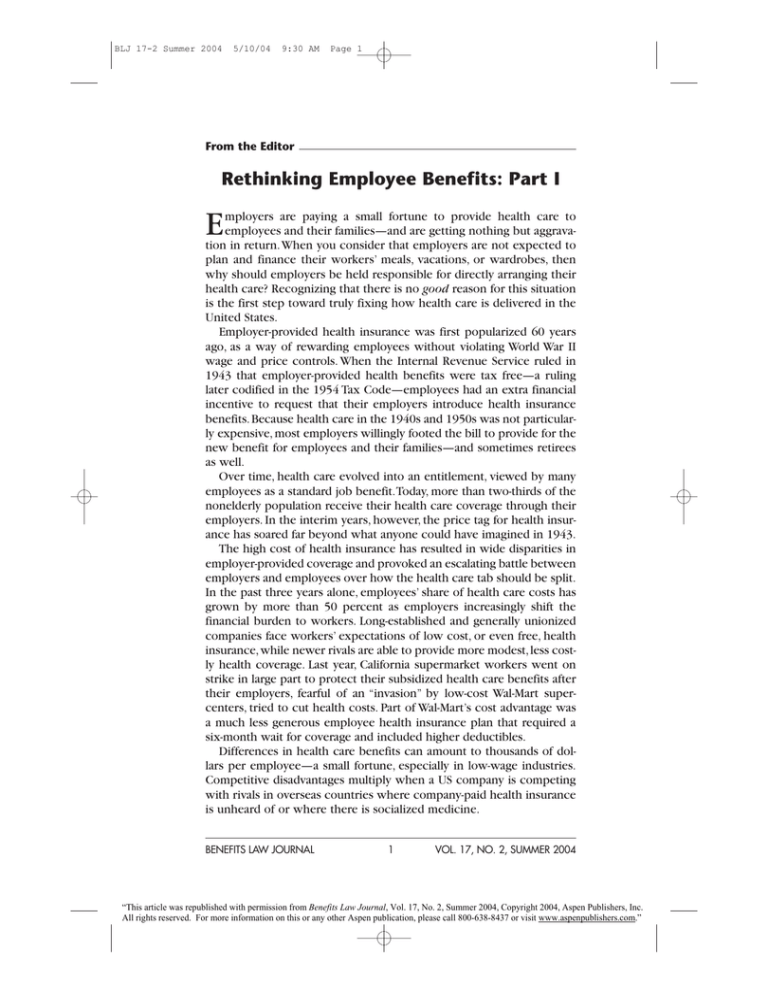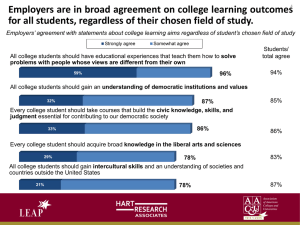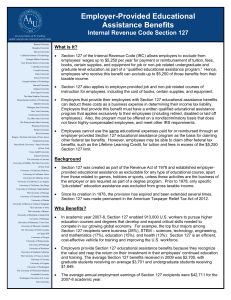
BLJ 17-2 Summer 2004
5/10/04
9:30 AM
Page 1
From the Editor
Rethinking Employee Benefits: Part I
mployers are paying a small fortune to provide health care to
employees and their families—and are getting nothing but aggravation in return.When you consider that employers are not expected to
plan and finance their workers’ meals, vacations, or wardrobes, then
why should employers be held responsible for directly arranging their
health care? Recognizing that there is no good reason for this situation
is the first step toward truly fixing how health care is delivered in the
United States.
Employer-provided health insurance was first popularized 60 years
ago, as a way of rewarding employees without violating World War II
wage and price controls. When the Internal Revenue Service ruled in
1943 that employer-provided health benefits were tax free—a ruling
later codified in the 1954 Tax Code—employees had an extra financial
incentive to request that their employers introduce health insurance
benefits. Because health care in the 1940s and 1950s was not particularly expensive, most employers willingly footed the bill to provide for the
new benefit for employees and their families—and sometimes retirees
as well.
Over time, health care evolved into an entitlement, viewed by many
employees as a standard job benefit.Today, more than two-thirds of the
nonelderly population receive their health care coverage through their
employers. In the interim years, however, the price tag for health insurance has soared far beyond what anyone could have imagined in 1943.
The high cost of health insurance has resulted in wide disparities in
employer-provided coverage and provoked an escalating battle between
employers and employees over how the health care tab should be split.
In the past three years alone, employees’ share of health care costs has
grown by more than 50 percent as employers increasingly shift the
financial burden to workers. Long-established and generally unionized
companies face workers’ expectations of low cost, or even free, health
insurance, while newer rivals are able to provide more modest, less costly health coverage. Last year, California supermarket workers went on
strike in large part to protect their subsidized health care benefits after
their employers, fearful of an “invasion” by low-cost Wal-Mart supercenters, tried to cut health costs. Part of Wal-Mart’s cost advantage was
a much less generous employee health insurance plan that required a
six-month wait for coverage and included higher deductibles.
Differences in health care benefits can amount to thousands of dollars per employee—a small fortune, especially in low-wage industries.
Competitive disadvantages multiply when a US company is competing
with rivals in overseas countries where company-paid health insurance
is unheard of or where there is socialized medicine.
E
BENEFITS LAW JOURNAL
1
VOL. 17, NO. 2, SUMMER 2004
“This article was republished with permission from Benefits Law Journal, Vol. 17, No. 2, Summer 2004, Copyright 2004, Aspen Publishers, Inc.
All rights reserved. For more information on this or any other Aspen publication, please call 800-638-8437 or visit www.aspenpublishers.com.”
BLJ 17-2 Summer 2004
5/10/04
9:30 AM
Page 2
From the Editor
A separate issue with employer-provided health care is that employees at the same skill and salary level can have vastly different total compensation costs depending on their personal habits and age. Think
about the likely health care bill for a sedentary, 55-year-old, overweight
smoker, compared to a 35-year-old nonsmoker who spends an hour a
day at the gym. Nonetheless, employers—correctly—are legally prohibited from taking these obvious difference into account in determining
wages or whom to hire.
Yet another consequence of treating health insurance as a fringe
benefit is that it turns employers into de facto decision makers on their
workers’ health care coverage. Many small employers end up choosing
whatever insurance program is most readily available or preferred by
the boss, while larger employers are more likely to rely on benefits professionals to search the market for coverage at the lowest cost.
Depending on the company they happen to work for, employees may
be offered one policy, a choice between high and low coverage and an
HMO, or a menu of a dozen offerings. Regardless, employees must
choose from what their employers make available.
Not only is the system unfair and arbitrary, it does not work. As a
nation, we spend nearly 15 percent of our gross domestic product
($5,440 a person) on health care—yet 43.6 million people remain
without any health insurance at all. The uninsured come largely from
the ranks of the unemployed, workers with no company-provided
health benefits, and those who cannot afford the premiums for their
company’s plan but earn too much to qualify for Medicaid.This results
in either the human tragedy of untreated illnesses or, because hospitals
generally must treat anyone who shows up needing emergency care,
the costs of treating the uninsured are passed on to everyone else
through higher insurance rates.The fact that the uninsured usually do
not receive routine medical care exacerbates their health problems by
the time they receive treatment in the emergency room, further driving up costs.
As things stand now, however, employers remain the best source of
employees’ health care coverage for three reasons. First, no matter how
meager the contribution, anything the employer contributes toward
health care is a help. Second, the entire premium—both the employer
and the employee piece—is paid with tax-free dollars. Finally, individual policies offer fewer choices at a higher cost than employer-provided coverage. Until recently, most experts believed that individual coverage was more expensive than group coverage because of economies
of scale. But recent studies reveal that a large part of the cost differential is due to the fact that employers have, in effect, preempted the market. Since very few people seek individual coverage, these policies end
up being expensive and offer limited terms.
BENEFITS LAW JOURNAL
2
VOL. 17, NO. 2, SUMMER 2004
BLJ 17-2 Summer 2004
5/10/04
9:30 AM
Page 3
From the Editor
That leaves employers with the task of having to search, select, and
subsidize, to one degree or another, health care for their employees.The
steep administrative costs of providing such benefits—which are continuously mounting as a result of ERISA, COBRA, FMLA, HIPAA, tax, and
other regulations—do not show up in health care statistics but do
inflate the overall expense of providing health care.
This creates a system in which neither the employer nor the employees are particularly satisfied, and everybody is worried the problem will
only get worse.What are employee benefits attorneys supposed to recommend to their clients? Theoretically, companies could take a bold
stand against the injustice of the US health care system by terminating
their health plans, passing the cost savings directly to employees and
letting workers find and pay for their own health insurance.
Unfortunately, many employees would likely be unable to find adequate replacement polices in the individual insurance market, while
some employees would pocket the raise and take their chances being
uninsured. Clearly, unilateral action by employers is not the answer.
President Clinton actually had the right idea 10 years ago, when he
proposed a complete overhaul of the health care system. Unfortunately, his
initiative failed when his secret commission of experts proposed an all-ornothing approach that shunned incremental reform.Employers,employees,
medical providers, and insurance companies alike were terrified, and the
opportunity for change was lost.
It is time to try again.The employee benefits community should insist on
a national debate regarding the delivery of health care coverage that begins
without any preconceived notions.
Here are some of the options and my initial grading:
1. Continue to let the current, tax-subsidized—but otherwise free market—health care system operate. It does work—more or less—for those
with good jobs, those on Medicare, and those with a decent retirement
income. But for everyone else, it stinks. Clearly, the status quo has got to go.
This begets a grade of C-.
2.Mandate that all employers either provide a minimum required level of
health benefits or contribute to a government health care fund for all
employees—the Ted Kennedy approach.This has the obvious advantage of
getting coverage quickly for a lot of people and eliminating the competitive
disadvantage to companies that already provide health benefits. It won’t
help the unemployed or pre-Medicare retirees, however. It also would have
the effect of giving many low-wage workers what amounts to an enormous
compensation increase.Could their employers afford the raise? Would even
more jobs go to other countries? Since employers have no particular expertise in providing affordable health care, they should not be made responsible for this major national problem.The grade for this system is C.
3. Institute universal government health insurance—a sort of Medicare
on steroids. This also would get everybody covered in a hurry and
BENEFITS LAW JOURNAL
3
VOL. 17, NO. 2, SUMMER 2004
BLJ 17-2 Summer 2004
5/10/04
9:30 AM
Page 4
From the Editor
would not be that big a change, since Uncle Sam and state governments
already pay for nearly half of all health care through Medicare and
Medicaid (about 32 percent) and state programs (about 13 percent).
With the new Medicare drug benefit, that percentage will surely top 50
percent.Yet as much as employers have done a less than perfect job providing health care coverage,I can’t imagine the government doing it better. Medicare works, sort of, but few people needing major surgery today
would choose to be treated in England or another country with socialized medicine rather than in the United States. Few enterprises operate
particularly efficiently without the incentives that come when there is
money at stake. From long waits to rationed care, few who have insurance would opt for socialized medicine.This approach warrants a C.
4. Require that each citizen choose his or her own health insurance
from what is available on the open market, with a minimum level of
required coverage that includes preventive services as well as catastrophic care. Other levels of coverage could be set by the government,
but providers could also be free to design their own programs.Those
who cannot afford coverage (based on a gross income test) would
receive a taxpayer-financed health insurance allowance large enough
to buy at least the minimum level of coverage. No one would be
allowed to game the system by taking their chances without coverage
and forcing the rest of us to foot the bill when they end up in the emergency room. Except for the need-based allowance and mandatory coverage, this is pretty much how the federal government currently provides health insurance to its own employees: here’s a menu of
approved policies, go pick one.Another analogy is auto insurance.The
government mandates coverage, leaving the rest up to the individual.
Both systems seem to do the job, and either may work as the way to
efficiently deliver health care to all US employees. Employers then
would be removed from the burden of delivering health care. Those
currently providing health benefits would have the option of passing
the savings on in the form of raises.The net cost to society should be
lower and the inequity and arbitrariness of the current system would
be eliminated.This system evokes a rating of B+.
Anyway, it is time to start the debate.
David E. Morse
Editor-in-Chief
Kirkpatrick & Lockhart LLP
New York, NY
BENEFITS LAW JOURNAL
4
VOL. 17, NO. 2, SUMMER 2004


